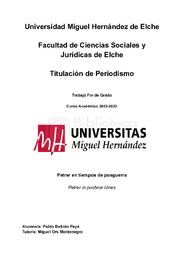Por favor, use este identificador para citar o enlazar este ítem:
https://hdl.handle.net/11000/29671Registro completo de metadatos
| Campo DC | Valor | Lengua/Idioma |
|---|---|---|
| dc.contributor.advisor | Ors Montenegro, Miguel | - |
| dc.contributor.author | Beltrán Payá, Pablo | - |
| dc.contributor.other | Departamentos de la UMH::Ciencias Sociales y Humanas | es_ES |
| dc.date.accessioned | 2023-10-17T10:57:21Z | - |
| dc.date.available | 2023-10-17T10:57:21Z | - |
| dc.date.created | 2023-06 | - |
| dc.identifier.uri | https://hdl.handle.net/11000/29671 | - |
| dc.description.abstract | La Guerra Civil es considerada como uno de los capítulos más oscuros de la historia de España, ya que durante tres largos años, republicanos y nacionales mantuvieron enfrentamientos violentos en todo el país, asolando y destruyendo municipios con el devenir del conflicto. Sin embargo, si bien es cierto que la guerra destrozó infinidad de familias, cuyas heridas incluso a día de hoy siguen sin cicatrizar, y todavía sigue generando debate entre las esferas de los distintos estamentos del país, el período que prosiguió a la guerra fue el que quizás mostró la España más fúnebre, pobre y débil que se recuerda. Fueron muchas las regiones y comunidades que tardaron lustros en recomponerse, pero entre todos ellos cabe destacar un municipio que, a pesar de que por aquel entonces no era tan conocido dentro de la Comunidad Valenciana, sirvió de bastión para los últimos días de la II República: Petrer. Este reportaje, gracias al testimonio de algunos petrelenses e historiadores locales, pretende revivir, desde el punto de vista de ambas ideologías, como se vivieron aquellos últimos instantes de la guerra y, sobre todo, cómo afrontó Petrer el periodo de posguerra. | es_ES |
| dc.description.abstract | The Civil War is considered one of the darkest chapters in the history of Spain, as for three long years, Republicans and Nationalists engaged in violent clashes throughout the country, devastating and destroying municipalities as the conflict wore on. However, while it is true that the war tore apart countless families, the wounds of which have yet to heal, and still continues to generate debate among the different sectors of the country, the period that followed the war was perhaps the one that showed the most funereal, poor and weak Spain in living memory. There were many regions and communities that took many years to get back on their feet, but among them all it is worth mentioning one municipality that, although it was not so well known in the Valencian Community at the time, served as a bastion for the last days of the Second Republic: Petrer. This report, thanks to the testimony of some petrelenses and local historians, tries to relive, from the point of view of both ideologies, how those last moments of the war were lived and, above all, how Petrer faced the post-war period. | es_ES |
| dc.format | application/pdf | es_ES |
| dc.format.extent | 39 | es_ES |
| dc.language.iso | spa | es_ES |
| dc.publisher | Universidad Miguel Hernández de Elche | es_ES |
| dc.rights | info:eu-repo/semantics/openAccess | es_ES |
| dc.rights | Attribution-NonCommercial-NoDerivatives 4.0 Internacional | * |
| dc.rights.uri | http://creativecommons.org/licenses/by-nc-nd/4.0/ | * |
| dc.subject | Guerra Civil | es_ES |
| dc.subject | España | es_ES |
| dc.subject | Petrer | es_ES |
| dc.subject | II República | es_ES |
| dc.subject | Posguerra | es_ES |
| dc.subject | Civil War | es_ES |
| dc.subject | Spain | es_ES |
| dc.subject | II Republic | es_ES |
| dc.subject | Postwar | es_ES |
| dc.subject.other | CDU::0 - Generalidades.::070 - Periódicos. Prensa. Periodismo. Ciencias de la información | es_ES |
| dc.title | Petrer en tiempos de posguerra | es_ES |
| dc.title.alternative | Petrer in postwar times | es_ES |
| dc.type | info:eu-repo/semantics/bachelorThesis | es_ES |

Ver/Abrir:
Memoria TFG_Pablo_Beltrán_Payá.pdf
16,71 MB
Adobe PDF
Compartir:
 La licencia se describe como: Atribución-NonComercial-NoDerivada 4.0 Internacional.
La licencia se describe como: Atribución-NonComercial-NoDerivada 4.0 Internacional.
.png)